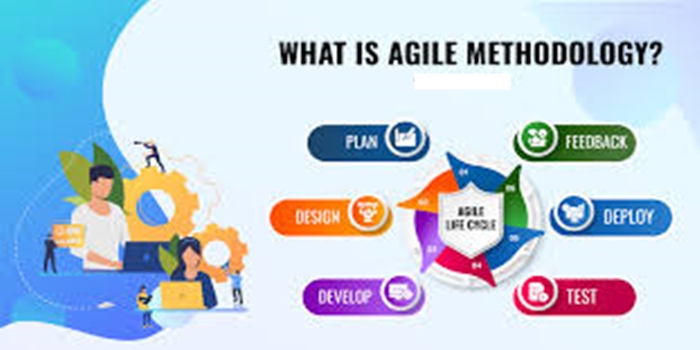In this article, we discussed the meaning of agile methodology, the types, the examples, the process, and also the benefits.
Definition
Agile methodology is a project management framework that highlights collaboration, adaptability, and continuous improvement. It’s a reiterative approach that breaks projects into phases, or sprints, to deliver products quickly.
Types of Agile methodologies include:
Scrum:
Widely used, focuses on short “sprints” with daily stand-ups, a Scrum Master, and clear roles within the team.
Kanban:
Visualizes work using boards, emphasizing limiting work in progress (WIP) and optimizing workflow.
FDD (Feature-Driven Development):
Prioritizes features and involves detailed domain modeling, design, code, and inspection steps.
DSDM (Dynamic Systems Development Method):
Focuses on delivering software on time and within budget, with strong communication and user engagement.
RAD (Rapid Application Development):
Prioritizes rapid prototyping and quick feedback loops to quickly develop and adjust products.
Scrumban:
Combines the structured approach of Scrum with the flexibility of Kanban for a hybrid approach.
Examples of Agile methodologies include:
Feature-Driven Development (FDD):
A method that prioritizes features and creates detailed development plans for each feature.
Dynamic Systems Development Method (DSDM):
Focuses on rapid delivery of products with an emphasis on business aspects of software development.
Extreme Programming (XP):
Emphasizes practices like pair programming and test-driven development to ensure high quality.
Scrum:
Considered one of the most popular Agile methodologies, focusing on collaborative teamwork with a defined process using “sprints” to deliver work in short cycles.
Kanban:
A visual workflow management system emphasizing continuous delivery and managing work in progress through a board with columns representing different stages.
Agile methodology involves different processes and it includes:
Planning:
Defining project goals, breaking down work into smaller tasks (user stories), and prioritizing features based on value.
Iteration:
A short timeboxed period where the team focuses on developing a specific set of features, including design, coding, testing, and review.
Feedback Loop:
Regular communication with stakeholders to gather feedback on the developing product, allowing for adjustments and improvements within the current iteration.
Retrospective:
A team meeting after each iteration to reflect on what worked well, what could be improved, and how to adapt for the next iteration.
Core Agile values:
Individuals and interactions over processes and tools:
Prioritizing strong team collaboration and communication.
Working software over comprehensive documentation:
Delivering functional software regularly is more important than extensive documentation.
Customer collaboration over contract negotiation:
Actively engaging with the customer to gather feedback and adapt to changing needs.
Responding to change over following a plan:
Embracing flexibility and adapting to evolving requirements throughout the project.
Popular Agile frameworks:
Scrum:
A structured framework with defined roles (product owner, scrum master, development team), events (sprint planning, daily scrum, sprint review), and artifacts (product backlog, sprint backlog).
Extreme Programming (XP):
Emphasizes short iterations, pair programming, continuous integration, and frequent customer feedback.
Kanban:
A visual system for managing work in progress, using a board with columns representing different stages of development.
The Benefits of Agile Methodology
Customer satisfaction
Customer collaboration: Agile encourages frequent feedback loops with customers.
Faster fixes: Agile iterative approach allows for quick fixes and solutions.
Faster time to market
Incremental delivery: Agile delivers software in increments, which helps businesses respond to market changes.
Flexibility
Adaptability
Agile allows teams to quickly adapt to changing requirements, priorities, or market conditions.
Unexpected challenges
Agile allows for swift addressing of unexpected challenges or opportunities.
Improved product quality
Testing: Every iteration of the product is tested until all the features have been fixed and improved.
Better team morale
Collaboration: Agile fosters a collaborative environment where team members work closely together, share ideas, and support each other.
Transparency
Client collaboration: Agile encourages frequent communication and continuous feedback, integrating clients closely into the development process.
Continuous improvement
Learning: Agile encourages continuous improvement and learning.
Conclusion
Agile methodology is a project management approach that breaks projects into smaller, iterative phases called “sprints,” prioritizing collaboration, adaptability, and customer feedback to deliver working.


